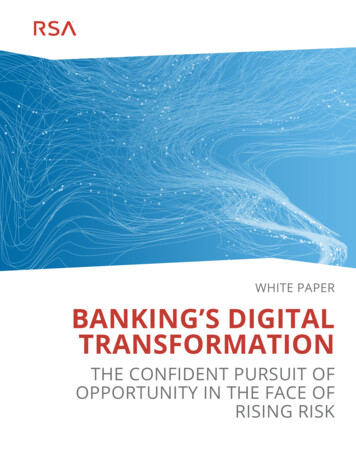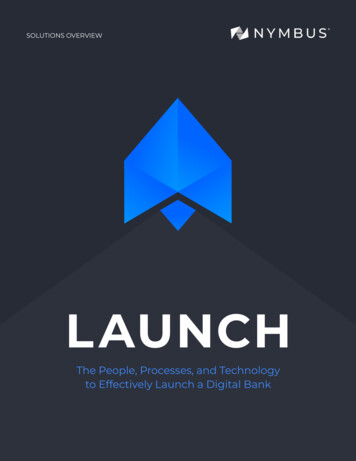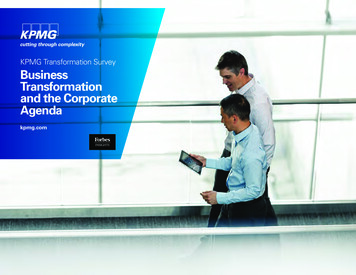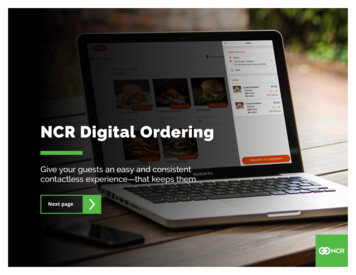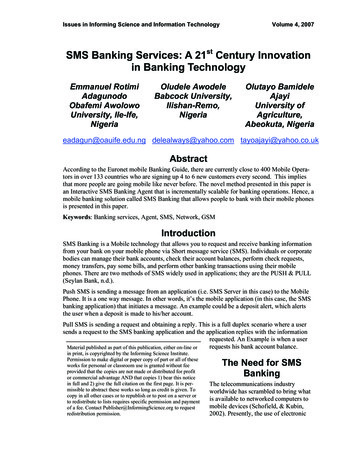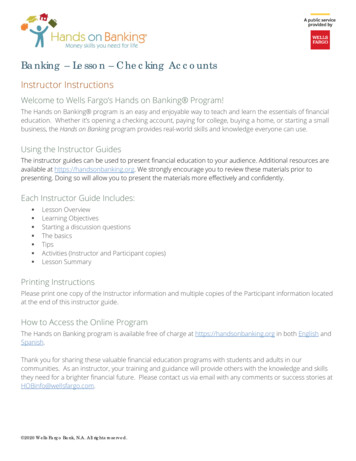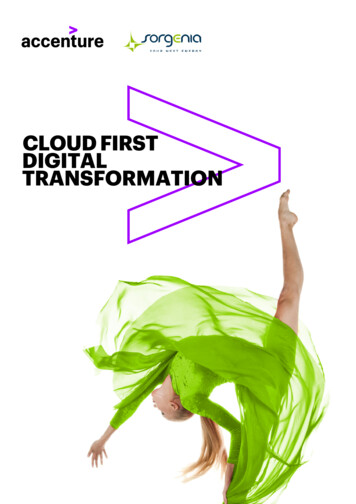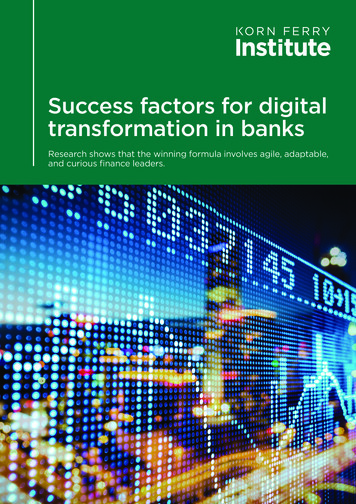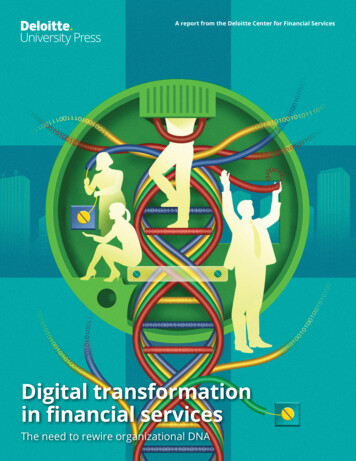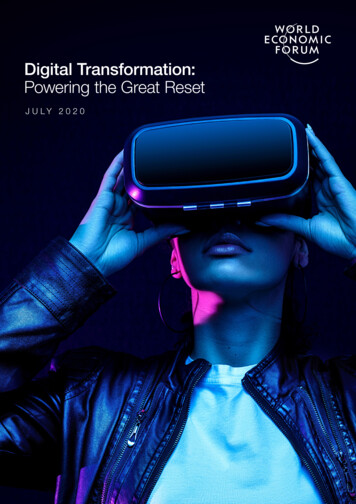
Transcription
DIGITAL TRANSFORMATIONIN BANKING – THE FUTUREOF BANKINGToday’s demand of banking is:anytime anywhere banking. thisrequires innovative, robust,secure, optimized and ready tomeet the expectations of empowered and tech-savvy customersHappiest People . Happiest Customers
ContentsAbstract.2Introduction.,.6Banking industry perspective.6Need for Omni-channel.7Wealth management.8 Current Process.9 Enhanced Process.9 Technology.10Whats in there for me ?.10Serving whats browsed, not only asked.10 Current Process.,.11 Enhanced Process.11 Technology.12About.the author.132 Happiest Minds Technologies. All Rights Reserved
AbstractDigital Transformation is far beyond just moving from traditional banking to a digital world. It is a vital change in how banksand other financial institutions learn about, interact with and satisfy customers. An efficacious Digital Transformationbegins with an understanding of digital customer behavior, preferences, choices, likes, dislikes, stated as well as unstatedneeds, aspirations etc. And this transformation leads to the major changes in the organizations, from product-centric tocustomer-centric view.A study by CGI entitled, Understanding Financial Consumers in the Digital Era sheds some light on the desires of today’sdigital consumer. Interestingly, at a time when financial institutions seem to be in a lock-step with each other, consumersare raising the bar on their expectations. And, according to the study by CGI, they are willing to leave where they currentlybank if their needs are not met.Top five consumers wants in bankingReward me for my businessGive me anytime , anyplace,access to my balance81%61%58%See me as a personProvide me with wealthbuilding adviceTell me what I am Spendingmoney on and how I can save55%52%The most effective way to understand and bring the organization from traditional banking to digital banking is Omni-Channel approach. Omni-channel is a multichannel approach to customer service where all the channels are tightly integrated,keeping customer in the center of the integration.As customers continue to change their channel usage patterns, banks and credit firms need to focus on delivering a seamless customer experience across various touch points. More than just an axiom, Omni-channel banking is a prospect totake bottom-line on higher note by gaining insights from customers’ channels, behavior and preferences. Today’s customers are more sophisticated and tech savvy, and to cater to their specific needs, each customer needs a unique experiencefrom banking. They want the companies to understand their unstated needs as well as their likes. So, it should come asno surprise that these customers are expecting similar kind of response and service from banking institutions too. Fromresearching new services, opening an account, checking balance, conducting transactions, loans, credits, wealth management, customer support, delivering an Omni-channel experience has become a key to success in this competitivemarket place.3 Happiest Minds Technologies. All Rights Reserved
Channel innovations bankersbeiieve deliver the most valueMobileOnlineBranch75%Mobile payments70%Automated accountorigination70%Analytics ledcross-sell sugesstion59%Personalizationof marketingoffers67%Financialplanning tools70%Services on multipledevice types46%Personalizedmobilemarketing others53 %Personal financialmanagementtools53%360 degree viewof customersentering branchIn the current multichannel model, customers are directed to the least expensive channel which grounds to not only thedissatisfaction, but also the channel hopping. The whole process is inefficient, costly and inconsistent. Omni-channel isnot the replacement of multichannel, but it’s the enrichment. Espousal of Omni-channel is indispensable to ensure thatcustomer experience is unified, incorporated and supports customer at the right time, in the right place as the right way. Itmust be as per their mobile and digital life style. Staying germane in current banking revolution entails deep acquaintanceof customers’ needs, wants and demands. It also requires the precise mixture of IT infrastructure and innovative new technologies to certify that one remains ahead in current market space to drive top, as well as bottom lines upwards. 59.5BNorth American banks IT spending will grow to 59.5 Billion in 2014, and much of that will be inretail baanking, with focus on enhancement tothe user experience and omnichannelsales and service endeavors35% of banks ‘ market share in North Americacould be at risk by 2020, as traditional branchbanking gives way to digital banking and asnew competition emergesSource “ A Crucial straegy for bank braanches in 2014” Celent Ressearch, BankTechnology April 17, 2014Source “ online/ mobile bankingPwC India’s leader banking and capital markets, Shinjini Kumar said, “Many Indian banks, like their Asian counterparts,are geared to use the advantage of local talent and leapfrogging technology to create forward looking digital strategies.However, there is a lot of ground to cover on creating Omni-channel experience and enhancing processes from thecustomer’s point of view.”PwC’s Financial Services Technology Leader, Julien Courbe, says “We’re heading into the co-creation phase, whereconsumers help develop the personalized products and services they want. The ultimate goal is to establish communitiesof individuals, stakeholders and enterprises working together to produce value through engagement platforms, designed4 Happiest Minds Technologies. All Rights Reserved
to enable mutual collaboration.” Despite proliferation of digital, that goal has not been easy to achieve. In fact, banks alsofall short of creating an Omni-channel experience - allowing customers to interact with banks effortlessly across all channels regardless of transaction type - as less than half of survey respondents (43%) indicate that online and mobile channelsare currently operating on a multi-channel platform.Few statistics on the future of customer engagement: 73% of marketers view customer centricity as critical to the success of their business and role at the company. (TheCMO Council, Mastering Adaptive Customer Engagement 2014) 70% of buying experiences are based on how the customer feels they are being treated. (McKinsey) A 2% increase in customer retention has the same effect as decreasing costs by 10%. (Leading on the Edge of Chaos,Emmet Murphy and Mark Murphy) In the retail banking industry, customers who are fully engaged bring 37% more annual revenue to their primary bankthan do customers who are actively disengaged. (Gallup State of the American Consumer 2014) Fully engaged policy owners purchase 22% more types of insurance products than actively disengaged policy owners.(Gallup State of the American Consumer 2014) The majority of businesses are unable to support an Omni-channel customer journey. (Forrester Wave CustomerService Solutions 2014) Only 12% can provide a seamless hand-off between channels. (Forrester Wave Customer Service Solutions 2014)An omni-channel strategy brings all the key parameters – online and offline channels, data and technology, customerbehavior and experience – all, onto one platform. Although the concept has there been for quite some time, companiesshied away from using it to their benefit, mostly due to critical considerations like increase in the number of apps, technology support, operations, silos between branches and online services that need to be broken, and conflicting priorities. Business need to integrate the various management systems while implementing Omni-channel, which is multifarious,prolonged and an expensive affair.A side from affinity for personal interaction“The challenge for many banks is that they haveat the branch, speed and ease of use area long - standing culture of branch- centricdriving factors in banking consumersbanking” says Mark Schwanhaus, director ofdecisions regarding channel usagrae. Whenomnichannel financial services at javelinasked why they chose a different option than“ you can’t wait for the customer to comethe branch for their latest transaction, overinto the branch with their problems. you need40% of those who used either online bankingto be proactive and reachout to the customeror mobile banking said what they neded towith answers through the digital channels”do was quicker and easier via these automatedchannelBig data analytics can help extend a single view to the consumer. Companies can use data from social media sites tounderstand their customers better. In addition to this, data available from pervious online searches and purchases canhelp target the right individual. Omni-channel, if successfully implemented, can lead to improved brand recognition andrevenues, increased customer base, enhanced customer experience, and competitive differentiation.5 Happiest Minds Technologies. All Rights Reserved
IntroductionBanking industry perspectiveBanking industry is going through a phase of commoditization. In today’s scenario, differentiated and delightful customerexperience has become more important than just providing financial services. To grab a bigger piece of the cake, bankingindustry has to understand the unstated needs of the customer the way airlines understands the preferences of thefrequent flyers or the retailers understand the likes/dislikes of their customers, without even taking direct feedback of thecustomer.Each and every day, new devices / technologies are providing various customer touch points. Every time customers toucha computer or a screen, they are providing an information trail and it's banks’ responsibility to understand how they usethis trail to move their bottom line upwards. Traditionally, banks spent most of their efforts, time and money on transactionexecution, which is nothing but has become a very basic feature of their overall service. While providing expedient,consistent and precise transaction processing ability is still critical, we believe that banks can learn from how retailers seethe customers’ journey through an Omni-channel lens. Banks now need to rethink the way customers are being valued,may be from the angle of the industries that greatly value customer experience.A tightly coupled multichannel may provide a share of customer’s pocket, but successful implementation of Omni-channelcan surely increase the size of the share though competitive advantage and also can help them to retain the same sharefor a longer period of time.Millionaires aren’t the only ones who want to bank whenever or wherever they want, irrespective of the branch location orthe business hours. Customers from all generation, income groups, and countries could make a transaction online oneday, and another day, the same transaction through mobile or ATM - or they could start a transaction on any of thesechannel then continue on another and finish it on different channel. Multichannel gives the flexibility to hop between channel, but not the continuation of the transactions among multiple channels. So, this represent a remarkable challenge forthe financial institutions, which are often involved in multiple types of banking such as retails, finance, corporate, mortgage etc.6 Happiest Minds Technologies. All Rights Reserved
Need for omni-channelAs of today, various channels are working in their silos, but it's time to break their silos and renovate the banking experience by instigating Omni-channel strategy. This approach is based on a single brand name, providing customer centricexperience to each and every customer as per their preference and behavior just like an individual bank for every customer – and so smoothly transacted that it becomes seamlessly embedded in the customer’s lifestyle.Various channels, but not limited to, which are the part of the omniOmni-channel: Branches: Up to 65 percent of customers prefer the branch for rich advice and personalized attention Mobile: 32 percent of the U.S. customers currently bank using their mobile devices Video: More than one-quarter (28 percent) of customers value video access to remote experts Social Media: There is emerging interest in tapping the power of social media like Facebook and Twitter to deliverfina
Digital Transformation is far beyond just moving from traditional banking to a digital world. It is a vital change in how banks and other financial institutions learn about, interact with and satisfy customers. An efficacious Digital Transformation begins with an understanding of digital customer behavior, preferences, choices, likes, dislikes, stated as well as unstated needs, aspirations etc .File Size: 2MBPage Count: 13Explore furtherSix digital growth strategies for banks McKinseywww.mckinsey.comDIGITAL FINANCIAL SERVICES - World Bankpubdocs.worldbank.orgThe Four Pillars of Digital Transformation in Bankingthefinancialbrand.comDigital Banking: Strategy, Trends and Transformationwww.customer.comDigital Transaction Banking Opportunities & Challengeswww2.deloitte.comRecommended to you based on what's popular Feedback
